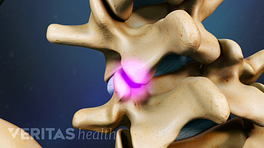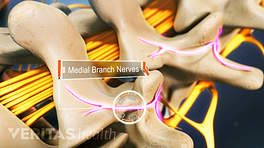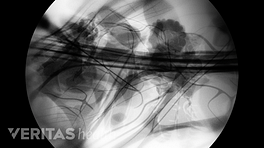A medial branch nerve block is a type of injection used to determine if the facet joint is causing the patient's back pain. Facet joints are pairs of small joints between the vertebrae in the back of the spine.
The facet joints — also called zygapophysial joints — provide stability, while also allowing the spine to bend, flex, and twist. Each facet joint contains small nerves, called medial branch nerves, that carry pain signals from the facet joints to the brain.
A variety of conditions can lead to inflammation of the facet joints, such as spinal stenosis or osteoarthritis, or from a trauma to the back, such as a car accident. If there is inflammation of the facet joints, the medial branch nerves will transmit pain signals to the brain.
A medial branch injection procedure begins with the patient laying face down on a table. The physician injects a local anesthetic, which numbs the skin and the tissue around the facet joint.
Next, the physician uses X-ray guidance, called fluoroscopy, to direct a small needle over the medial branch nerves. A small amount of contrast dye is injected to confirm that the medicine covers the medial branch nerve. Following this confirmation, a numbing medicine, called an anesthetic, is slowly injected onto each targeted nerve.
Typically two adjacent medial branch nerves that travel at contiguous levels of the spine are injected in one procedure.
If the patient experiences significant pain relief immediately after the injection, then the facet joint is determined to be the source of the patient's pain and the patient may be a candidate for a follow-up procedure, called a medial branch radiofrequency neurotomy, that may provide longer pain relief.
In This Article:
- Medial Branch Nerve Blocks
- Medial Branch Injection Procedure
- Risks and Complications of Medial Branch Blocks
- Medial Branch Block Video










